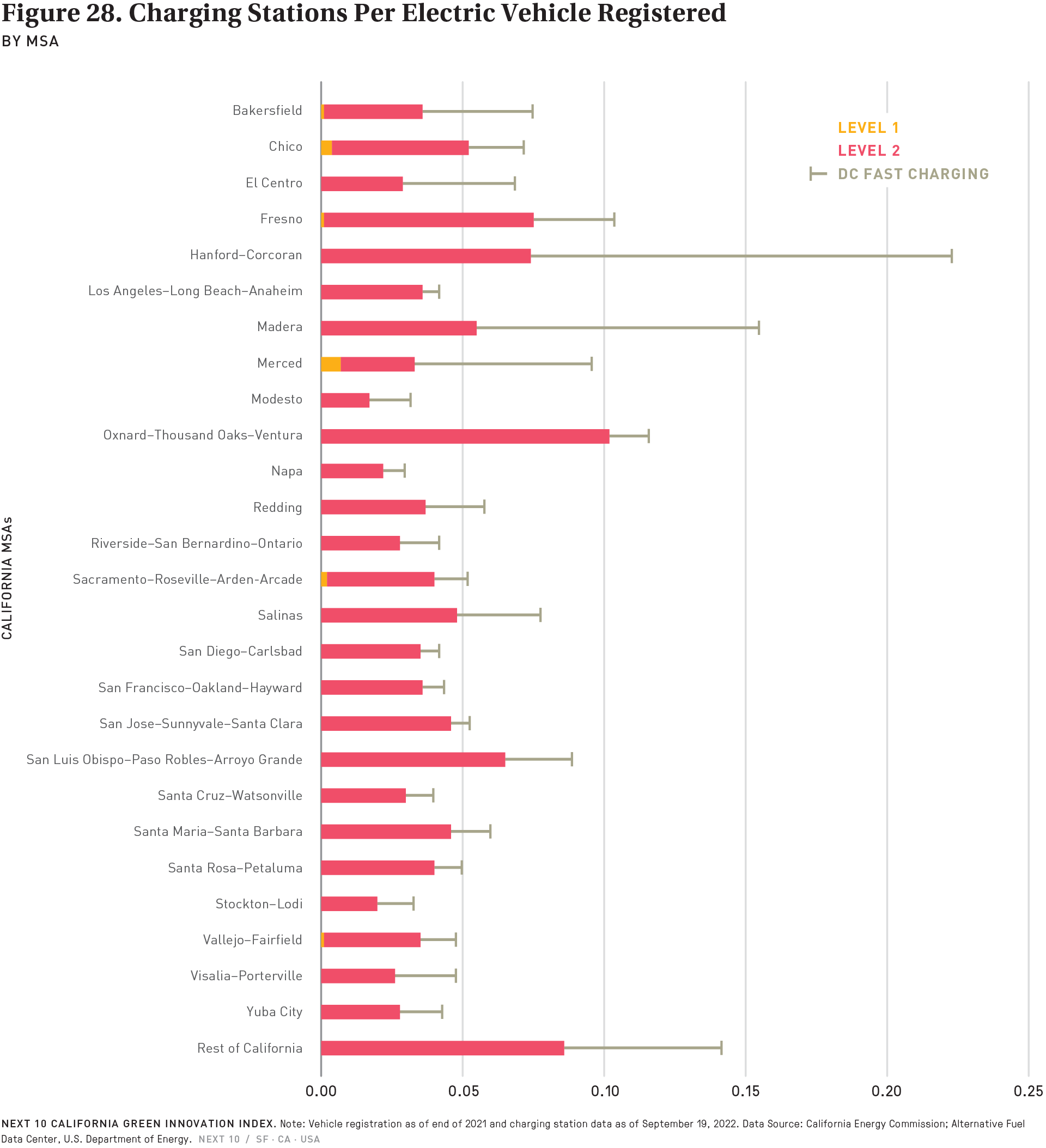Highlight
- Statewide, public charging infrastructure is gradually expanding. As long-range ZEVs become more common, Level One charging stations are disappearing (-26.2% in 2021) in favor of faster Level Two and DC fast-charging infrastructure. Since ZEV penetration is lower in more rural and less-populous metro areas, these regions also tend to have a greater number of charging stations per electric vehicle. Similar to 2020, the non-MSA region of the state had the second-lowest number of EVs per non-DC public charging station (11.6)—behind only Napa (9.8)—and the number increased by 2.2 percent from the previous year. Most notably, public charging infrastructure is expanding the most rapidly in less urban MSAs in California—Redding (+100%), Hanford-Corcoran (+73.6%), Merced (+62.2%), and Bakersfield (+56.4%).
Challenge
- The California Energy Commission’s study of Assembly Bill 2127, passed in 2018, estimates that the state needs 1.164 million charging stations—including 508,000 public and DC fast charging stations—to achieve the goals of the Executive Order N-79-20.107 As of January 31, 2022, there were 37,780 public Level 1, Level 2, and DC fast-charging stations in California—or 7.4 percent of the 508,000 public and DC fast charging stations needed to achieve the goal. The overall the number of stations per EV showed a downward trend. Furthermore, California increased the share of new ZEVs registered by 25.3 percent in 2021—11.7 percent more than the growth of total EV charging stations over the same time period.
107 The full report (CEC-600-2021-001-REV) is available on California Energy Commission’s website at: https://www.energy.ca.gov/news/2021-06/report-shows-california-needs-12-million-electric-vehicle-chargers-2030
Opportunity
- Recognizing the shortfall in public charging stations supply, under the National Electric Vehicle Infrastructure (NEVI) Formula Program in the IIJA, a total of $5 billion has been allocated to developing and constructing a national network of 500,000 EV charging stations by 2030.108 California is expected to receive $77 million annually ($384 million total over five years) of federal IIJA funds through this program to install public charging infrastructure along designated national highway system corridors.109 The passage of Assembly Bill 2700 (AB 2700) will also enable more strategic grid planning and investment to ensure that the grid is able to accommodate widespread transportation electrification when needed to meet the state’s goals. The bill addresses a critical barrier for EV charging infrastructure deployment that could otherwise act as a bottleneck in future EV adoption, wherein there are not enough chargers for the growing number of EVs on the road.110
108 Foley & Lardner LLP. U.S. DOT Releases NEVI Formula Program Guidance, Giving Public and Private Stakeholders a Roadmap for EV Infrastructure Funding. February 24, 2022. Retrieved from: https://www.foley.com/en/insights/publications/2022/02/us-dot-releases-nevi-formula-program-guidance
109 “The California 2022-23 Spending Plan: Resources and Environmental Protection.” California Legislative Analyst’s Office. Available at: https://lao.ca.gov/Publications/Report/4633
110 Muller, Miles. “Newsom Signs Law to Ready the Grid for EV Adoption.” NRDC. September 19, 2022. Available at: https://www.nrdc.org/experts/miles-muller/newsom-signs-law-ready-grid-ev-adoption

